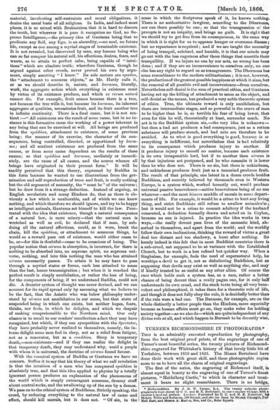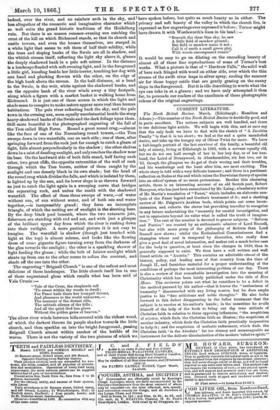TURNER'S RIC EIMONDSHIRE IN PHOTOGRAPHS.* Tim is an admirably executed
reproduction by photography, from the best original proof prints, of the engravings of one of Turner's most beautiful series, the twenty pictures of Richmond- shire engraved for Whittaker's history of that lovely little bit of Yorkshire, between 1819 and 1823. The Misses Bertolacci have done their work with great skill, and these photographic copies seem to us to have all the charm of original engravings.
The first of the series, the engraving of Richmond itself, is almost equal in beauty to the engraving of one of Turner's finest pictures, " Heidelberg Castle," to which in character and treat- ment it bears no slight resemblance. There is no bridge,
• Riehmondshire. By J. M. W. Turner, B.A. The twenty subjects photo- graphically reproduced by C C. and M. E. Bartolacci, iu one c =plots vo.unta, with a concise unor.cal preface. Loudon : Published for C. C. and M. E. Bertolsoel, by Messrs. Willis and Sotheran, 136 Strand; and alit, fur them by Maser,. Colusghi, Pall Mall East, and Messrs. A. Marion, Soo, and Co., Soho Square.
indeed, over the river, and no rainbow arch in the sky, and less altogether of the romantic and imaginative character which so well suits A° grand historic traditions of the Heidelberg ruin. But there is an unseen summer-evening sun catching the crest of the hill on which Richmond stands, so that its church and castle towers, and even the houses themselves, are steeped in a white light that seems to rob them of half their solidity, while the trees and sloping banks of the Swale are all in shadow, and the whitish stream itself, reflecting the light sky above it, glasses the deeply shadowed bank in a pale soft mirror. In the distance is a landscape flooded with soft evening light, and in the foreground a little girl, kneeling beside her little terrier, touching her dog with one hand and plucking flowers with the other, on the edge of the high bank above the stream. In the half-distance, at a bend in the Swale, is the weir, white against the shadowed banks, and on the opposite bank of the river winds away a tiny footpath,
along which a figure with a market basket is walking home from Richmond. It is just one of those scenes in which the light and shade seem to conspire to make nature appear more real than human habitations. The pale river reflecting back the sky, and the pale
town in the evening sun, seem equally unsubstantial beside the steep heavy-shadowed banks of the Swale and the dark foliage upon them. Still more beautiful is the photographed engraving of the fall of the Tees called High Force. Round a great round crag,—almost like the face of one of the Nuremberg round towers,—the Tees sweeps down in two waterfalls, one on each side ; one of them, after springing forward from the rock just far enough to catch a gleam of light, falls almost perpendicularly in the shadow ; the other shelves down in a mist of dazzling sunlight, and onlyreaches the shadow near its base. On the landward side of both falls stand, half facing each other, two great cliffs, the opposite extremities of the wall of rock through which the Tees bursts, neither of them caught by the sunlight and one densely black in its own shade ; but the head of the round crag which divides the falls, and which is isolated by them, is lighted up by the sun, and its lower slope is so thrown forward as just to catch the light again in a sweeping curve that bridges the separating rock, and unites the sunlit with the shadowed waterfall. The effect of these three sweeps of wave, —of water without sun, of sun without water, and of both sun and water together, is inexpressibly grand; they form an incomplete triangle, of which the uniting arc of sunlight is the slanting base. By the deep black pool beneath, where the two cataracts join, fishermen are standing with rod and net, and with just a glimpse Of the brilliant upper day from which the river is rushing down into their twilight. A more poetical picture it is not easy to imagine. The waterfall in shadow (though just touched with light at the top) is almost solemn, and looks like the flowing dress of some gigantic figure turning away from the darkness of the glen towards the sunlight ; the other is a sparkling shower of light feeding the gloom ; while the belt of fainter sunlight which slants up from one to the other seems to soften the contrast, and shade off the one into the other.
The engraving " Brignall Church" is one of the softest and most delicious of these landscapes. The little church itself lies in one of those sequestered glens which recalls what has been said of Vela Crucis :—
" Vale of the Cross, the shepherds tell 'Tis sweet within thy woods to dwell ; For Peace hath there her tranquil throne, And pleasures to the world unknown,— The murmur of the distant rills, The sabbath silence of the hills ; And all the quiet God has given Without the golden gates of heaven."
The silver river winds between hills covered with the richest wood, of which the darkest throws its purple shadow towards the little church, and then sparkles on into the bright foreground, passing Brignall Church almost within earshot of the bubble of its waves. There is not the variety of the two pictures of which we
have spoken before, but quite as much beauty as in either. The privacy and soft beauty of the valley in which the church lies, is expressed as few engravings ever expressed it before ; Turner might have drawn it with Wordsworth's lines in his head "Beneath the clear blue sky, he saw A little field of meadow ground ; But field or meadow name it not ; Call it of earth a small green plot, With woods encompassed round."
It would be easy to go on dilating on the exceeding beauty of almost all of these fine reproductions of some of Turner's best works. What a picture is that of " IIardraw Falls," the solid wall of bare rock fringed with wood on either side, over which the thin stream of the swift river leaps in silver spray, cooling the summer air for those happy cattle that are gently grazing on the sunny slope in the foreground. But it is idle describing in words what the eye can take in at a glance ; and we have only attempted it thus far, to persuade our readers of the excellence of these photographic echoes of the original engravings.































 Previous page
Previous page